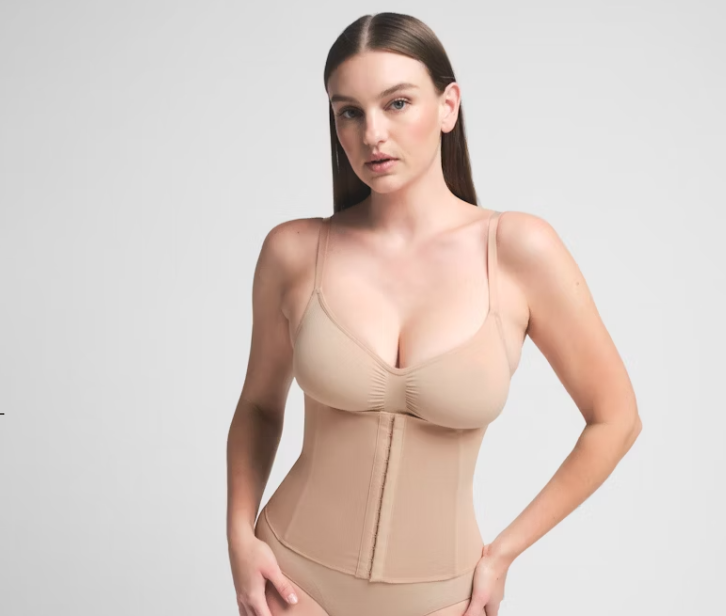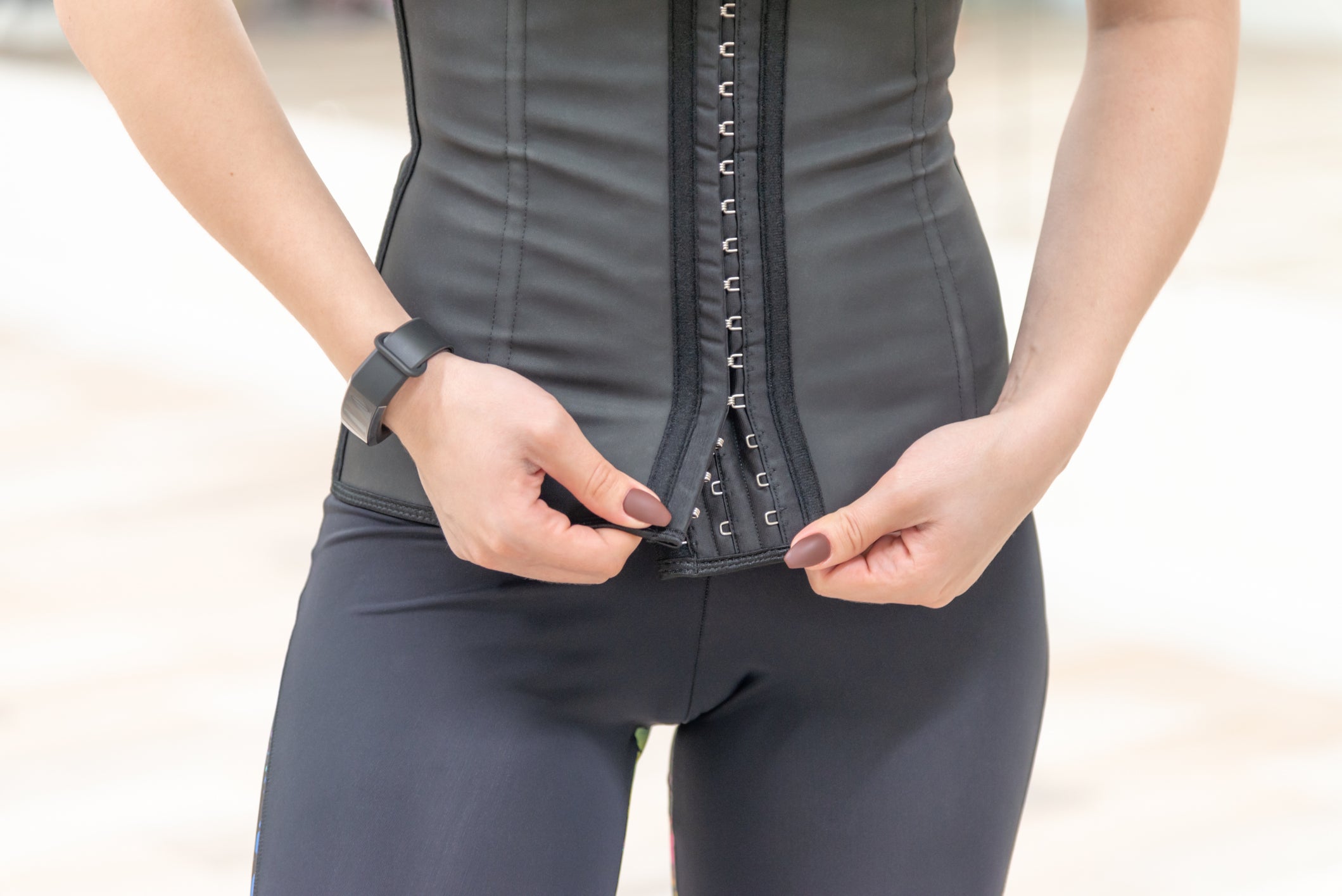At the slight age of 16, Chloe* would button herself into a waist training belt before leaving the house. She would wear the corset-style device – a long piece of tight fabric that squashes the torso into a smaller size – at the gym, to school, or to sleep. Her vision board was Kylie Jenner, the half-sister of Kim Kardashian, and her hourglass figure, contoured cheekbones and plump lips (this period where Jenner’s influence on young girls was at its peak is known on the internet as the “King Kylie” era).
Chloe, now 26, found it hard to resist. “Among my friends, there was this competition to see how long you can keep the waist trainer on for, or what size you could go down to,” she tells me. She noticed others taking it further: some of her peers would wear two at once for extra cinch. “I would wear it under a really tight top I owned, and a pair of high-waisted skinny jeans,” she says. “When I look back at it, I do feel quite sad because I was so young.”
That was a decade ago, when it was quickly dismissed by older women who looked on in disbelief as the young used their pocket money to buy whatever trainer Jenner was endorsing. Shockingly, despite the online discourse at the time, the waist trainer trend is making a comeback. And it’s not just teens embracing it this time.
Online, you’ll find swathes of influencers recommending wearing them overnight as part of a regimented viral beauty routine, known as the morning shed. The trend sees influencers apply a ludicrous number of different ointments, creams and beauty hack devices before they sleep, which they film themselves peeling off the following morning. Among waist compression devices, there are overnight face masks for clearer skin, elasticated chin straps to apparently achieve a defined jawline, and nose tape to manipulate the shape of the nose bridge without surgery. The list goes on.
The return of waist trainers is on the heels of shapewear’s big rebrand, thanks to Kim Kardashian’s wildly successful lingerie brand Skims (and her cola-bottle-shaped figure), which has essentially remarketed shapewear as the latest in-vogue accessory. The brand, which was founded in 2019 and is now worth more than $4bn, sells viral sculpting bodysuits geared towards achieving this particular hourglass body shape. In the process, the shapewear industry has been given a PR facelift, relegating it from being Bridget Jones’s most shamed possession – those nude-coloured tummy control knickers she wears underneath her Christmas party frock – to something that women now proudly (and publicly) embrace. It’s all in pursuit of achieving the coveted “slim-thick figure”, comprised of a slender waist and stomach, but curvier hips and thighs.
With waist trainers, specifically, the draw lies in the “training” aspect. They are sold – cheaply on fast fashion sites and for £74 at Skims – under the mythical belief that wearing one for extended periods can aggressively shave inches off your waist and promote fat loss. In one advert recommended to me online, a model claims to have lost five inches after wearing a training corset for six to eight hours per day. Waist trainers are also surprisingly prevalent in gym content, with many TikTok creators purporting that wearing a tight-fitting belt during exercise will promote excessive amounts of sweat around the stomach, thus (supposedly) targeting weight loss in that area. Other self-anointed experts recommend wearing one throughout the day, even if you’re resting. There’s conflicting information out there. But the real question is, though: do we know what these devices are actually doing to our bodies?
Sure, women have worn corsets since the 16th century – so you may ask what the fuss is all about. But when early shapewear emerged, it was not as a sculpting device, but for practical support of the body, in the same way that a contemporary bra is made to support the breasts today. These days, though, modern shapewear devices, like the waist trainer, are geared towards transforming the silhouette of the body on a long-term basis. Waist trainers, then, have become part of people’s daily wellness and fitness regimes, in the hope that the product will fulfil its magical pledges.
It’s worth establishing that there is no actual scientific evidence to support the claim that waist trainers can lead to fat loss or change the shape of the body on a long-term basis. Dr Rupa Parmar, medical director at private GP practice Midland Health, tells me that the real impact could instead be a range of potential medical-related side effects, which can vary from shortness of breath to digestive problems and weakened abdominal muscles, depending on how much you’re wearing them.

“If you’re restricting the waist and squashing everything in, you’re not allowing enough space for movement of the diaphragm,” she tells me. The muscle that separates your chest cavity from your abdominal cavity then “has to move up and down quite significantly, to allow for lung expansion”. This could lead to shortness of breath or even fainting.
Another concern is the compressive effect on the digestive system. “It could lead to heartburn, bloating, constipation reflux,” says Dr Parmar. And, if you’re over-wearing your waist trainer, and not engaging your abdominal muscles while wearing it – it can lead to a weakened core. “Those muscles are not going to work in the same way because they’re constantly being squashed and compressed, so it could actually lead to worsening muscle tone, particularly the core muscles,” she adds.
If you’ve spent the best part of 24 hours wearing a waist trainer, you might take it off and think you look more toned. Or that your waist is a little narrower. But it’s usually an illusion. Dr Parmar says that waist trainers can have a short-term effect on altering the appearance of the midriff and stomach area, but it won’t be long-lasting after you remove the device. “That illusion is likely to only be due to mild fluid loss,” she explains. “Maybe even through sweating, compression and not actual fat loss or reshaping of the body.”
Shapewear is being celebrated under the guise of wellness or fitness. But it’s easy to develop an unhealthy relationship and overreliance on certain products to counter self-esteem issues. Victoria Kleinsman, a self-esteem expert and body love coach who works with women between the ages of 13 to 60, tells me that she’s worked with several clients who have used waist trainers, usually alongside having a disordered relationship with eating or their body. “It’s about fear, control, trauma, or the need for love and acceptance,” she says. Kleinsman will never shame a person for wearing one, but “help them explore what they think it’ll give them in emotional terms”. “Then we begin the work of meeting those needs in healthier, more sustainable ways,” she says. “I help them reconnect to their body not as an object to sculpt, but as a home, a partner, and a source of wisdom and joy.”
Kleinsman thinks that the reemerging trend surrounding waist trainers is a way of telling young women that their bodies “aren’t enough” and should therefore shrink or reshape themselves to be desirable. “Waist trainers sell more than just compression. They sell hope. Hope for acceptance, validation, and desirability. Young women are constantly bombarded with messages, both overt and subtle, that their worth is tied to how small, toned, or ‘disciplined’ their body is,” she says.
Dr Parmar is also clear not to shame the use of using waist trainer, but for people to really consider why they’re wearing one in the first place. “It’s worth asking what you are trying to achieve with the waist trainer, and consider other methods of changing body shape first,” she says. “That’s looking at working muscle groups, looking at dietary changes and core exercise such as pilates and yoga.”

If somebody does want to wear a waist trainer for short periods, say underneath a figure-hugging dress for a rare event, then Dr Parmar isn’t as concerned about the health impacts. “I’m not advocating there’s a role for them, but if somebody does have a special occasion as a one-off, and they’re wearing it for two or three hours, then that may well aid that slimming appearance of the waist. But it’s worth remembering that’s not going to help longer term.”
Chloe has noticed that many of the celebrities marketing these products have undergone plastic surgery, so it’s easy to be misled by the advertising that hides behind bodies that are not actually anatomically possible for the vast majority of people. And Kleinsman agrees. “When celebrities with huge platforms endorse these products, often without transparency around surgeries, editing, or professional help behind their bodies, it creates a deeply unrealistic and toxic standard,” she says. “What’s most worrying is how ‘normalised’ body manipulation has become. Young girls are being introduced to body shame earlier than ever, and products like waist trainers feed the belief that your natural body isn’t good enough. That’s incredibly damaging.”
Chloe’s collection of three waist trainers still sits in her wardrobe at home, but she isn’t drawn to them like she was before. “I was so conscious about how I looked and it came from insecurities,” she says. “I wouldn’t recommend it to anyone. It’s uncomfortable and dangerous – and it can get addictive.”
*name changed
#Waist #trainers #making #comeback



